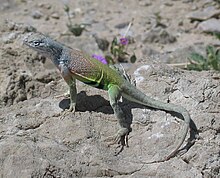| Greater earless lizard | |
|---|---|

| |
| Cophosaurus texanus (male) | |
| Scientific classification | |
| Domain: | Eukaryota |
| Kingdom: | Animalia |
| Phylum: | Chordata |
| Class: | Reptilia |
| Order: | Squamata |
| Suborder: | Iguania |
| Family: | Phrynosomatidae |
| Genus: | Cophosaurus Troschel, 1852 |
| Species: | C. texanus
|
| Binomial name | |
| Cophosaurus texanus Troschel, 1852
| |
The greater earless lizard (Cophosaurus texanus) is the only species in the monotypic genus Cophosaurus. It is closely related to the smaller, lesser earless lizards and other species in the genus Holbrookia, and in fact was placed in that genus and referred to Holbrookia texana from 1852 into the 1970s. Earless lizards lack external ear openings, an adaptation to burrowing in the sand, as are the recessed lower jaw and flared upper labial scales. Greater earless lizards are sexually dimorphic, males grow larger and are more colorful than females, exhibiting pink and green colors that are particularly bright in the breeding season. Two bold black bars mark the lateral region of males but are greatly reduced and vague, or occasionally entirely absent in females.
The greater earless lizard is native to the Chihuahua Desert and other arid and semi-arid regions of Southwestern United States and northern Mexico, where they most often occupy moderately open areas of sparse vegetation with rocks, gravel, and sand. The overall color of individual lizards frequently match the colors of the rocks and soils of the local area they inhabit. They will often rely on camouflage and their speed to elude threats and predators before retreating into rock crevices. They are primarily insectivores, preying on wide variety of crickets, grasshoppers, caterpillars, ants, flies, beetles, and bugs. Spiders and small lizards are occasionally eaten as well. Cophosaurus are oviparous. Females lay 1 to 4 clutches of 2 – 9 eggs a year, with hatchlings emerging from June to October, and reaching adult size and sexual maturity in one year.
- ^ "Cophosaurus texanus (Greater Earless Lizard)". The IUCN Red List of Threatened Species. Archived from the original on 2016-03-02.
